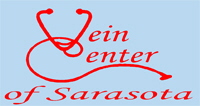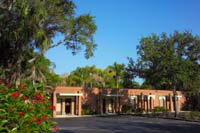Vein Disease-Causes
What causes
varicose veins?
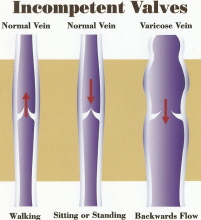 Arteries
bring oxygen rich blood from your heart
to the tissues of your body. Veins
return oxygen poor blood back to the
heart so that the cycle can begin over
again. Arteries
bring oxygen rich blood from your heart
to the tissues of your body. Veins
return oxygen poor blood back to the
heart so that the cycle can begin over
again.
You have
two kinds of leg veins, superficial and
deep. Deep veins lie in the muscles and
are responsible for almost all of the
blood return back to the heart.
Superficial veins lie close to the skin
and are connected to the deep veins.
Normally, one way valves ensure that the
blood flow goes from the feet up toward
the heart and always flows from
superficial to deep veins.
When these one way valves no longer
function properly, blood flows backward
toward the feet and from the deep veins
to the superficial veins. This back
pressure is called venous reflux and
causes dilated superficial veins in the
legs called varicose veins.
The main underlying cause of varicose
veins is malfunction of the normal one
way valves in the veins.
Why do valves malfunction?
This can be due to either destruction of
the valves or dilatation of the veins so
that the valve edges don’t meet
properly. Although we do not know why
this happens, we do know that there are
certain things that are related to such
findings. These predisposing factors
include:
-
Age- aging causes wear and tear on
the valves in your veins.
Eventually this wear and tear causes
valves to malfunction, not close
properly, and leak.
-
Sex- women are more likely than men
to develop the condition. Hormonal
changes during pregnancy,
pre-menstruation, or menopause may
be a factor. Female hormones can
relax vein walls and cause
dilatation of the veins. Taking
hormone replacement or birth control
pills may increase your risk of
varicose veins.
-
Genetics- varicose veins tend to run
in families.
-
Obesity- being overweight causes
more pressure in lower extremity
veins and encourages dilatation and
leakage.
-
Standing for long periods of time
causes blood to pool in the lower
extremities and encourages
dilatation and incompetence (or
leaking) of the valves.
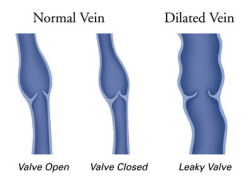
Vein Disease-Varicose and Spider
Veins
There are two types of abnormal veins
that you should be able to recognize if
you are going to understand about lower
extremity venous problems.
 First,
there are the typical varicose veins
that are dilated superficial veins on
the surface of the legs. The word
“varicose” comes from the Latin word
“varix” that means “twisted.” Varicose
veins are usually bulging, twisted,
lumpy, and sometimes have a bluish
discoloration. First,
there are the typical varicose veins
that are dilated superficial veins on
the surface of the legs. The word
“varicose” comes from the Latin word
“varix” that means “twisted.” Varicose
veins are usually bulging, twisted,
lumpy, and sometimes have a bluish
discoloration.
These bulgy type of varicose veins are
almost always due to a leak in either
the great saphenous, small saphenous, or
perforator veins connecting the deep and
superficial systems. As blood backs up
into the superficial veins due to the
leaky or incompetent valves, these large
bulging varicose veins can become more
pronounced and larger. The pooling of
the pressurized blood causes veins to
stretch and bulge and, if left
untreated, these varicose veins can lead
to blood clots or large ulcers on the
leg.
Thanks to endovenous technology, the
problem responsible for these bulgy
varicose veins can be corrected in the
office with a minimally invasive
procedure within minutes. These
procedures will be discussed further on
this website.

The second type of abnormal veins are
spider veins. These are typically just
below the skin surface, are not dilated
or bulging, are very conspicuous and are
bluish or redish in color. Instead of
being large and ropy the spider veins
are thread-like and do not pose a threat
to a person’s health. They are not
usually associated with a leak in a
major vein and are mostly a cosmetic
problem.
Unfortunately, spider veins recur even
after treatment modalities have been
employed. Most patients need
intermittent maintenance treatments to
keep their legs vein free.
Vein Disease Symptoms
Some common signs and symptoms of
varicose veins include:
-
Aching pain, burning, and throbbing.
-
Tenderness to palpation over certain
varicies
-
Easily tired legs
-
Leg heaviness
-
Leg swelling
-
Itching
-
Color changes with darkening of the
skin
-
Skin ulcers
The signs and symptoms are usually worse
with prolonged sitting or standing and
are relieved with exercise.
We see color changes and skin ulcers
with long standing venous disease that
is not treated. These changes are more
difficult to treat and that is why it is
important to seek medical advice and
treat varicose veins early before
significant consequences occur.
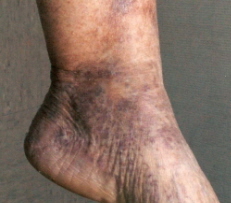
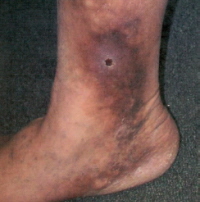
|
